The Kaveri Refresh 'Godavari' Review: Testing AMD's A10-7870K
by Ian Cutress on June 1, 2015 11:59 AM ESTProfessional Performance: Linux
Built around several freely available benchmarks for Linux, Linux-Bench is a project spearheaded by Patrick at ServeTheHome to streamline about a dozen of these tests in a single neat package run via a set of three commands using an Ubuntu 11.04 LiveCD. These tests include fluid dynamics used by NASA, ray-tracing, OpenSSL, molecular modeling, and a scalable data structure server for web deployments. We run Linux-Bench and have chosen to report a select few of the tests that rely on CPU and DRAM speed.
C-Ray: link
C-Ray is a simple ray-tracing program that focuses almost exclusively on processor performance rather than DRAM access. The test in Linux-Bench renders a heavy complex scene offering a large scalable scenario.
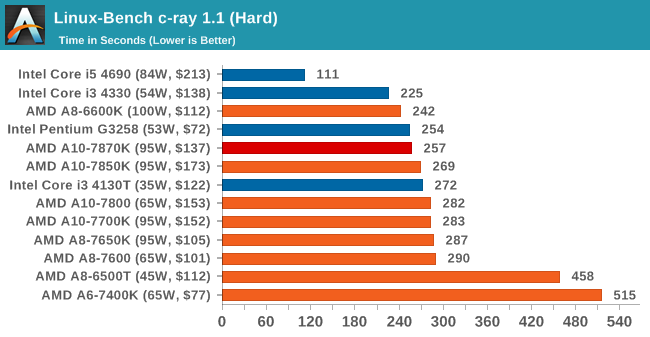
NAMD, Scalable Molecular Dynamics: link
Developed by the Theoretical and Computational Biophysics Group at the University of Illinois at Urbana-Champaign, NAMD is a set of parallel molecular dynamics codes for extreme parallelization up to and beyond 200,000 cores. The reference paper detailing NAMD has over 4000 citations, and our testing runs a small simulation where the calculation steps per unit time is the output vector.
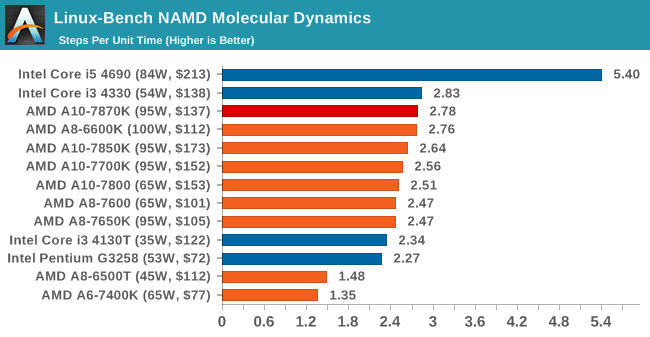
NPB, Fluid Dynamics: link
Aside from LINPACK, there are many other ways to benchmark supercomputers in terms of how effective they are for various types of mathematical processes. The NAS Parallel Benchmarks (NPB) are a set of small programs originally designed for NASA to test their supercomputers in terms of fluid dynamics simulations, useful for airflow reactions and design.
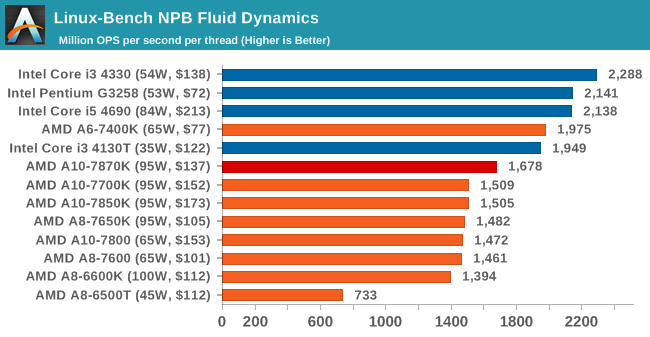
Redis: link
Many of the online applications rely on key-value caches and data structure servers to operate. Redis is an open-source, scalable web technology with a strong developer base, but also relies heavily on memory bandwidth as well as CPU performance.
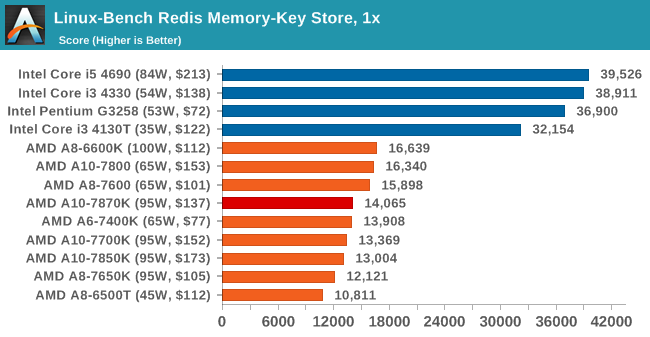

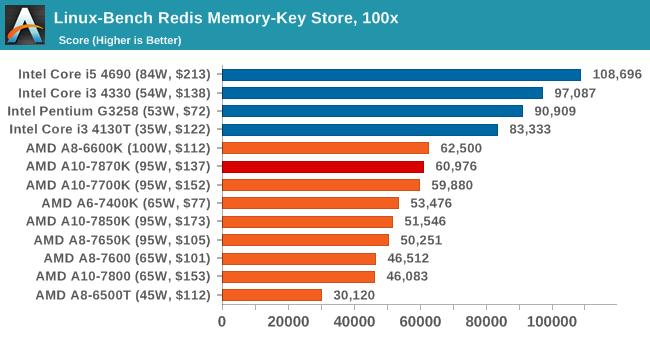










140 Comments
View All Comments
anubis44 - Wednesday, June 3, 2015 - link
Dual-core CPUs are dead men walking for gaming. If you've already got one, fine, you'll have to upgrade very soon. But recommending buying a dual-core chip NOW is uttery unconsionable, unless it's for your grandmother to play solitaire. The damn thing will choke just running windows and a web browser these days.anubis44 - Wednesday, June 3, 2015 - link
@RafaelHershel: "Less power means less heat and less noise. It also means better performance in a (very) small case. It also means a more modest PSU."But it's a question of proportion. How much money do you think you're saving in electricity by paying a lot more for an Intel processor? Check this out:
https://www.youtube.com/watch?v=fBeeGHozSY0
Not to mention in buying Intel and nVidia, you're supporting two companies with proven track records of ripping off customers, but please go right ahead and blithely do it.
jonez - Friday, June 5, 2015 - link
Why use a 4 years old linux distribution, it's even older than most of the hardware being benchmarked?And running it live it's not ideal too, but for the purpose of intra-comparison it's not that relevant, I guess.
ES_Revenge - Saturday, June 6, 2015 - link
I still don't understand why the Dual Graphics tests are not including Frame-Time Variance numbers/charts. It's one thing to have nice FPS from Dual Graphics but if the FTV is bad enough that it makes it no better than being on the solo-card (or the APU solo) then those numbers quickly become meaningless. Anandtech has commented on dual-GPU FTV stuff before, so I'm puzzled as to why it's not even mentioned as even a possible concern here with the Dual Graphics tests of the last few AMD APUs.ssv - Wednesday, June 10, 2015 - link
totally, off the track. Why is that AMD architectures are named after Indian rivers? Kaveri and Godavari are rivers in south India. I am not sure if earlier "Bima" refers to Bhima (indian again) mythological character.P39Airacobra - Sunday, June 21, 2015 - link
Sorry but 30fps at low settings and 720p is not what I would consider gaming capable! These APU's are just a waste of money! You can buy a X4 860K CPU and a old R7 260 for about the same price and actually be able to game!ricster7227@gmail.com - Tuesday, July 21, 2015 - link
I am presently running the A 5800 k APU for a couple + years and have waited a few cycles here and will take the plunge for this new chip. I presently OC to 5600 with an H-105 pushpull at about 36 degrees under load and it will be interesting to see the difference in performance and operation. I suspect this will improve my experience until my next build I7 or Zeons with ECC.ricster7227@gmail.com - Sunday, August 23, 2015 - link
The new APU is much stronger and faster than my A 5800 k. It is clocked at4400 which is slower however it is much faster for the normal office and light gaming. I can now do intensive rendering, watch and record HD video and surf the web at the same time. It stays under 30 degrees, doesn't slow down and hasn't crashed at all. I'm running the latest Insider 2010. It is a welcome addition and has increased my productivity by about double overall.gearhead99 - Monday, September 28, 2015 - link
the APU stuff is great for laptops, gimme gimme, but i don't see a good case for AM1 or FM2+. flexible upgrade path - no / cheap ECC - no / good IPC - no / good TDP - no / many cpu cores - no / low price - no. its especially unfortunate AMD has abandoned ECC. regardless of all the groaning over IPC, the bang4buck was pretty solid on AM2>AM3+SviatA - Friday, October 16, 2015 - link
Honestly, I wouldn't buy any video card in addition to any AMD APU. For me, gaming performance of my build is irrelevant since I don't like playing games. So if you are not going to do that (or use Adobe Photoshop for photo editing) then forget about Intel. APUs are good enough on power consumption and performance for simple home tasks.The only issue is that AMD doesn't really develop its processors. Which is a shame since they could give us impressive stuff. http://hardware.nl/amd/ad7600ybjabox.html - less than a 100, but performance wise, it will work fine.